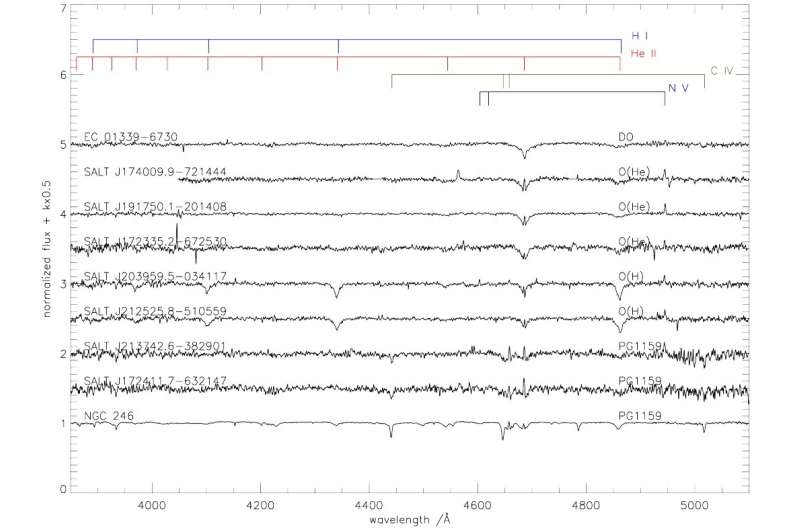SALT discovers new hot white dwarf and pre-white dwarf stars

Using the Southern African Large Telescope (SALT), an international team of astronomers has discovered eight new very hot white dwarf and pre-white dwarf stars with effective temperatures over 100,000 K. The finding is reported in a paper published in the Monthly Notices of the Royal Astronomical Society.
White dwarfs (WDs) are stellar cores left behind after a star has exhausted its nuclear fuel. Due to their high gravity, they are known to have atmospheres of either pure hydrogen or pure helium. However, a small fraction of WDs shows traces of heavier elements.
Although WDs have a relatively small size, comparable to that of the Earth, they are few million times more massive than our planet. Pre-white dwarfs (PWDs) are few times larger and slated to shrink in size, eventually becoming WDs within about a few thousand years.
Now, a group of astronomers led by Simon Jeffery of the Armagh Observatory and Planetarium, U.K., reports the detection of new WDs and PWDs with extreme temperatures. The new stars were discovered using SALT’s Robert Stobie Spectrograph (RSS) during the search for helium-rich hot subdwarfs.
“Serendipitously, the SALT survey for helium-rich subdwarfs has led to the discovery of eight hot white dwarfs and pre-white dwarfs with effective temperatures exceeding 100,000 K,” the researchers wrote in the paper.
According to the study, two newfound PWDs turned out to be PG 1159 stars—precursors of the DO white dwarfs or DA white dwarfs, retaining some hydrogen in their envelope, named after their prototype. The sample also includes one DO white dwarf, three O(He) and two O(H) stars.
It was found that one of the two O(H) stars is the central star of a newly-discovered planetary nebula (PN), while the other is the hottest O(H) star without a PN. The PG 1159 star designated SALT J213742.6−382901 (or J2137 for short) appears to be the hottest one out of the newly detected eight—its effective temperature was estimated to be about 180,000 K. Moreover, the DO white dwarf, with an effective temperature of 130,000 K, is the hottest DO WD so far detected.
J2137, together with the other PG 1159 star designated SALT J172411.7−632147 (or J1724) were found to be variable, with more than one period detected in the range of 600–1,200 seconds. The astronomers classified these two stars as GW Vir variables, which makes SALT J213742.6−382901 the hottest GW Vir variable known to date.
Summing up the results, the authors of the paper underlined that further studies of J2137 and J1724 could be crucial for testing theoretical models of stability in GW Vir stars. They propose more extended observations, most likely using space observatories, that would help to unveil their asteroseismic properties in detail.
More information:
C S Jeffery et al, Hot white dwarfs and pre-white dwarfs discovered with SALT, Monthly Notices of the Royal Astronomical Society (2023). DOI: 10.1093/mnras/stac3531. On arXiv: DOI: 10.48550/arxiv.2301.03550
© 2023 Science X Network
Citation:
SALT discovers new hot white dwarf and pre-white dwarf stars (2023, January 17)
retrieved 17 January 2023
from https://phys.org/news/2023-01-salt-hot-white-dwarf-pre-white.html
This document is subject to copyright. Apart from any fair dealing for the purpose of private study or research, no
part may be reproduced without the written permission. The content is provided for information purposes only.
For all the latest Science News Click Here
For the latest news and updates, follow us on Google News.

